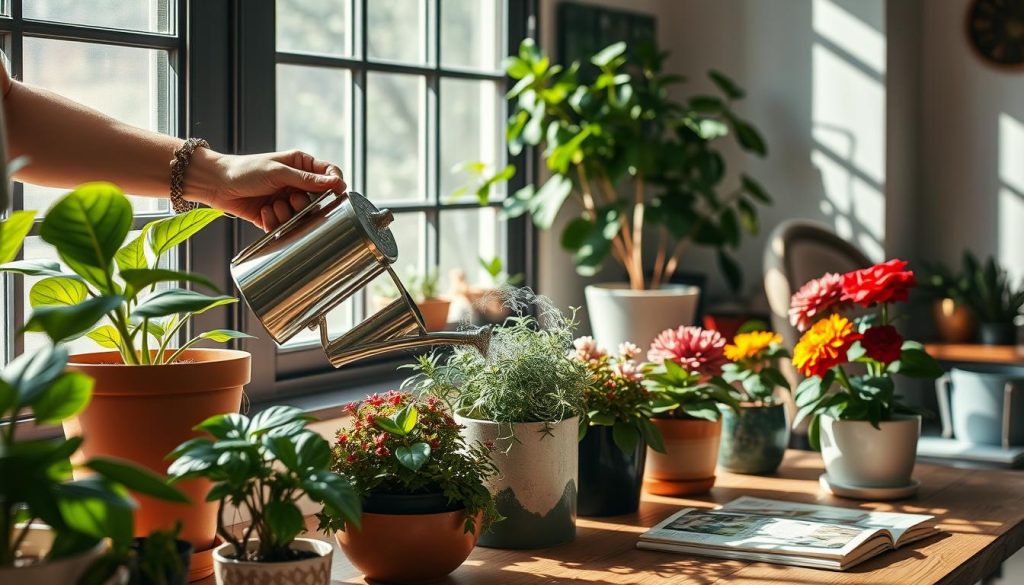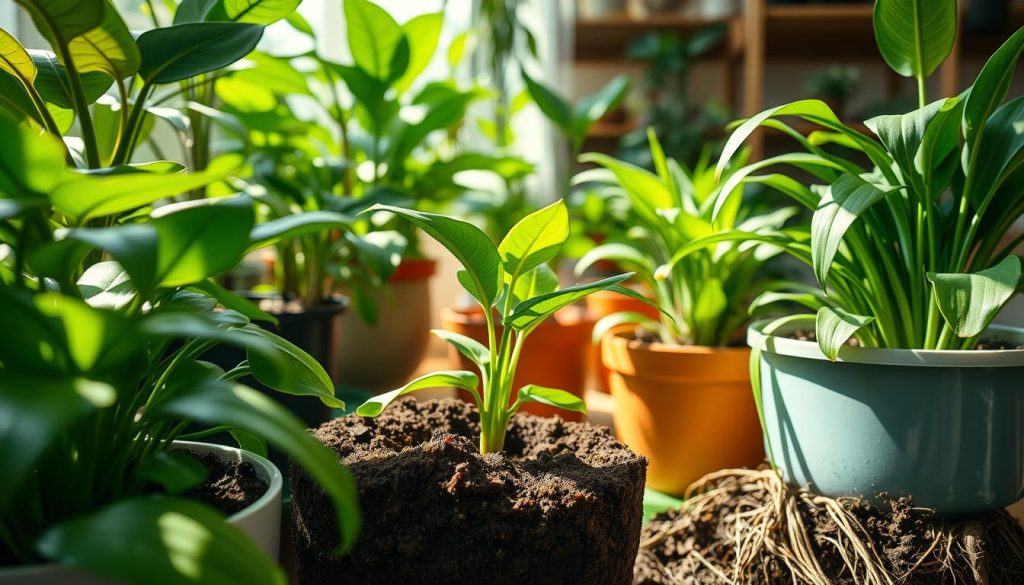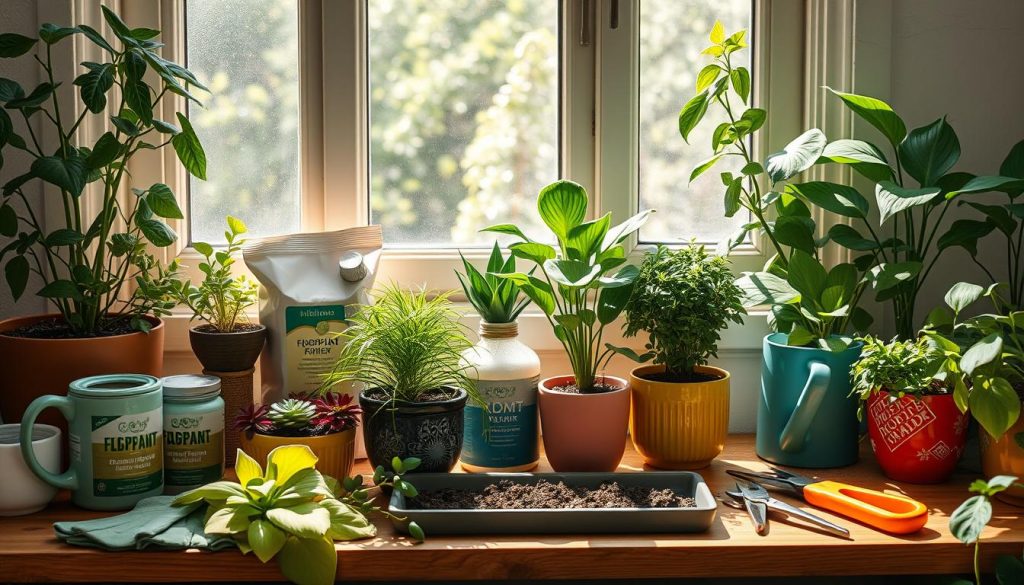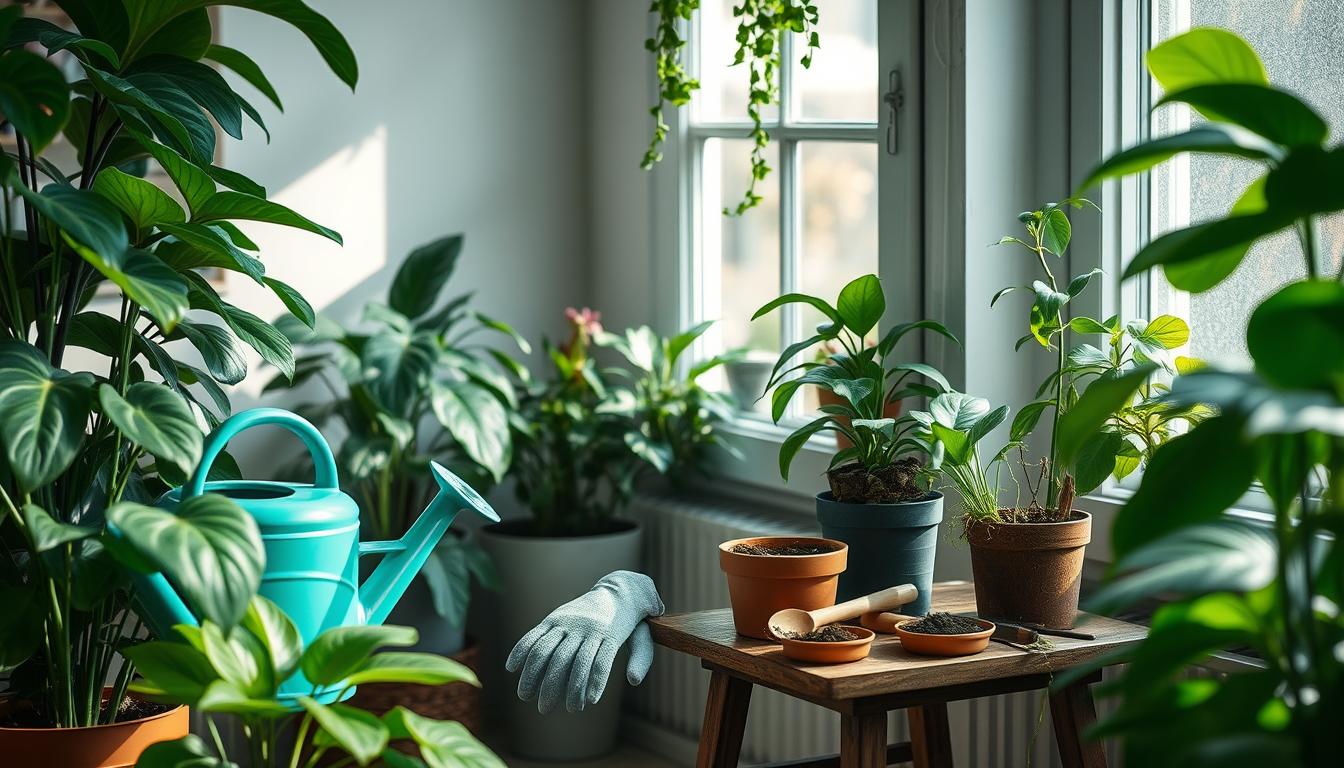I’m excited to share my journey in caring for houseplants. It’s been full of trial and error. As a seasoned enthusiast, I’ve found that the right care tips are key for their health and growth. With proper care, your plants can stay healthy and thrive.
Learning to care for houseplants might seem daunting, but it’s simple once you get the basics. I’ll cover watering, fertilizing, pruning, and propagating. This guide is for both beginners and experienced plant lovers. It’s packed with tips to keep your plants happy and healthy.
In this article, I’ll share my top methods for houseplant care. You’ll learn about indoor plant care and how to care for houseplants. By the end, you’ll know how to give your plants the best care and enjoy their benefits at home.
Understanding the Basics of Houseplant Care
To make your plants thrive, knowing the basics of houseplant care is key. A good plant watering guide helps ensure your plants get the right moisture. Learning the best practices for houseplant care helps you meet your plants’ needs.
When picking a plant, think about your space’s conditions. Consider the light and temperature it needs. Some plants love direct sunlight, while others prefer shade. A good guide will tell you how to care for your plants, including the best temperature and humidity.

- Light requirements: Direct sunlight, indirect sunlight, or shade
- Temperature: Ideal temperature range for the plant
- Humidity: Optimal humidity level for the plant
By considering these factors and following best practices, you’ll create a happy home for your plants.
Watering Techniques That Work for Me
Watering is key in houseplant care. Too much water can harm plants, causing root rot. Too little water makes leaves dry and weak. Knowing when to water is crucial.
To check if it’s time to water, I stick my finger into the soil. If it’s dry, I water. I also water plants well and let the soil dry a bit before watering again. This keeps roots healthy and plants moist.

Signs of Overwatering
- Yellowing or droopy leaves
- Soft, mushy stems
- Water pooling in the soil
Identifying Underwatering Symptoms
- Wilting or crispy leaves
- Dry, cracked soil
- Slow growth or discoloration
By following these tips, I keep my plants healthy. Houseplant care is about finding the right balance. With practice, you’ll get better at watering.
| Watering Technique | Benefits |
|---|---|
| Soak and Dry | Prevents root rot, promotes healthy growth |
| Room-Temperature Water | Prevents shocking the roots, reduces stress |
The Role of Soil in Plant Health
Soil is key to houseplant care. The right soil mix greatly affects plant health. Understanding soil’s role is crucial in caring for indoor plants.
Choosing the Right Soil Mix
A good soil mix balances nutrients, moisture, and air. For houseplants, choose a mix made for them. Peat or coconut coir mixes are great for drainage and keeping moisture.

Importance of Soil Drainage
Good drainage prevents waterlogged soil. This stops root rot and other issues. Add perlite or sand to ensure water drains well.
When to Repot Your Plants
Repotting is vital for indoor plants. Do it when soil lacks nutrients or the plant outgrows its pot. Fresh soil and a bigger pot support healthy growth.
Fertilizing Your Houseplants Effectively
Fertilizing is key in houseplant care. It gives plants the nutrients they need to grow well. A good plant watering guide includes fertilizing to keep soil balanced.
Knowing how to fertilize right is important. It helps your plants grow strong and healthy.
Understanding NPK Ratios
NPK ratios show the balance of nitrogen, phosphorus, and potassium in fertilizers. Each plant needs a different mix. Choosing the right fertilizer is crucial for your plant’s growth.
By following best practices, you can give your plants the nutrients they need. This ensures they grow well.
How Often to Fertilize
Fertilizing frequency varies by plant type, growth stage, and season. Usually, once a month is enough. But some plants might need more or less.
Remember, too much fertilizer can harm your plants. So, be careful not to overdo it.

Organic vs. Synthetic Fertilizers
You can choose between organic and synthetic fertilizers. Organic ones are safer for the environment. They’re made from natural materials.
Synthetic fertilizers are made from chemicals and can be stronger. Think about your plant care needs and choose wisely.
Managing Pests and Diseases
Keeping my houseplants healthy is a big part of houseplant maintenance. I’ve learned that spotting pests and diseases early is key. Here, I’ll share my experiences with common issues and how to tackle them.
Regular checks are essential to catch pests and diseases early. I inspect my plants often, looking for signs of trouble. Common pests like spider mites, mealybugs, and scale can harm my plants if not dealt with.
Common Houseplant Pests
- Spider mites: tiny, spider-like creatures that feed on plant sap
- Mealybugs: small, white, cottony insects that feed on plant sap
- Scale: small, armored insects that feed on plant sap
Signs of Disease and How to Handle Them
Signs of disease include yellow leaves, black spots, and powdery mildew. If I see these, I act fast to stop the disease. This might mean cutting off infected parts or using a fungicide.
Preventative Measures I Use
To avoid pests and diseases, I follow some key tips. I regularly inspect my plants, use neem oil to keep pests away, and ensure good air flow. These steps help my plants stay healthy and strong.
| Pest/Disease | Signs | Treatment |
|---|---|---|
| Spider mites | Yellowing leaves, fine webbing | Neem oil, insecticidal soap |
| Mealybugs | White, cottony patches | Neem oil, insecticidal soap |
| Scale | Small, armored insects | Neem oil, insecticidal soap |
Pruning and Grooming for Growth
Pruning and grooming are key for your houseplants’ health. They help your plants grow bushy and prevent them from getting too long. Regular pruning also keeps your plants looking good in your home.
Pruning is a must for houseplant care. Prune your plants in the spring and summer when they’re growing fast. This encourages new growth and stops them from getting too long.
Tools for Pruning
You’ll need sharp scissors, pruning shears, and gloves for pruning. Gloves protect your hands from thorns. Also, have a small pot to hold the cuttings.
Benefits of Regular Grooming
Grooming your plants regularly is important. It keeps them healthy by removing dead parts. Some benefits include:
- Improved air circulation around the plant
- Increased light penetration to the plant’s leaves
- Reduced risk of disease and pests
By following these tips and pruning regularly, your plants will thrive. Enjoy the many benefits of indoor plant care.
Propagating Your Favorite Plants
Sharing plants with friends and family is rewarding. It also helps you grow your collection. Start by picking plants that are easy to propagate. Succulents and leafy greens are great choices, thanks to a good plant watering guide.
Choosing the Best Plants for Propagation
Look for plants that are easy to grow and care for. Succulents are perfect because they need little care. Leafy greens do well in moist, well-draining soil, making them easy to care for.
Techniques for Propagation
There are many ways to propagate plants. You can divide mature plants, use layering, or take leaf cuttings. Division splits the roots of a plant. Layering bends a stem to the ground. Leaf cuttings involve rooting a leaf in soil or water.
Caring for Newly Propagated Plants
After propagating, your plants need the right care. Water them as the guide suggests, give them nutrients, and keep them airy. With these steps, your new plants will flourish and enhance your collection.
- Water your plants according to a plant watering guide
- Provide essential nutrients for healthy growth
- Keep your plants in a well-ventilated area
| Plant Type | Propagation Method | Care Requirements |
|---|---|---|
| Succulents | Leaf cuttings | Infrequent watering, well-draining soil |
| Leafy Greens | Division | Consistent moisture, fertilization |
Seasonal Care Adjustments
When seasons change, your houseplant care needs to adjust too. In winter, I water and fertilize less to avoid too much moisture and nutrient damage. But in summer, I water and fertilize more to help them grow well.
Here are some tips for seasonal care:
- Water plants half as much in winter to avoid root rot
- Fertilize 25% more in summer for healthy growth
- Prune in spring to encourage new growth and control size
These tips will help you care for your houseplants all year. Always watch how your plants react to the seasons and adjust your care as needed.
With these seasonal care tips, your houseplants will stay happy and healthy. You’ll enjoy the benefits of indoor gardening all year.
| Season | Watering | Fertilizing |
|---|---|---|
| Winter | Reduce by half | Reduce by 25% |
| Summer | Increase by 25% | Increase by 25% |
| Spring | Maintain regular schedule | Increase by 10% |
A Closer Look at Light Sources
Light is key when caring for houseplants. It’s vital for their growth. We’ll look at natural and artificial light, and the benefits of grow lights.
Knowing about light sources is crucial for houseplant care. Natural light is best, but it’s not always available. Grow lights are a good alternative, especially in winter.
Natural Light Considerations
Natural light is the top choice for indoor plants. If you have a sunny window, place your plants there. But, direct sunlight can be too strong and burn them.
Using Grow Lights Effectively
Grow lights are great for indoor plants, especially in winter. Choose a grow light based on your plants’ needs. Some need strong light, others soft light. Grow lights help your plants grow well.
Rotating Your Plants for Even Growth
Rotating plants is key for even growth and to prevent leaning. It’s crucial when using grow lights. Rotating ensures your plants grow evenly.
Follow these tips for a thriving indoor garden. Choose the right light, use grow lights wisely, and rotate plants for balanced growth.
Creating the Perfect Environment
To make the best home for my houseplants, I think about a few key things. These include where to place the plants, who they should be with, and how humid it should be. A well-thought-out space is key for my plants’ health and happiness. It’s a big part of my guide on watering plants.
Every little thing counts when it comes to taking care of houseplants. From the soil to the light, each part is important. By following the best care practices, I make sure my plants get what they need to do well.
Importance of Plant Placement
Where you put your plants is very important. It affects how much light and heat they get. I place my plants where they get the right amount of natural light, based on what they need.
Companion Planting Benefits
Companion planting helps create a balanced environment. It’s when you pair plants that help each other grow. For instance, marigolds can keep nematodes away from tomatoes.
Using Humidifiers or Pebble Trays
To keep the right humidity, I use humidifiers or pebble trays. This is crucial for plants that like it humid, like ferns and peace lilies. By doing this, I make sure my plants have the best chance to grow well.
Here are some more tips for a perfect environment:
- Use a plant watering guide to ensure your plants receive the right amount of water
- Consider the temperature and humidity levels in your home when choosing plants
- Experiment with different companion planting combinations to find what works best for your plants
By following these tips and thinking about what my plants need, I can create a great space for them. This helps them thrive.
Building My Plant Care Routine
Keeping a regular plant care routine is crucial for my houseplants’ health. I spend a few minutes each day, week, and month on plant care. This includes daily watering checks and monthly fertilizing.
Daily, Weekly, and Monthly Tasks
Every day, I check my plants for stress signs like wilting leaves or pests. I also check the soil moisture. Weekly, I water them thoroughly, adjusting as needed. Monthly, I fertilize with a balanced fertilizer to help them grow strong.
Keeping a Plant Care Journal
I keep a journal for my plant care routine. It logs watering schedules, fertilizer use, and any issues. This journal helps me track patterns and make better care decisions.
Staying Organized with Plant Care Apps
I also use plant care apps to stay organized. These apps remind me to water, fertilize, and track my plants’ progress. Using technology helps me give my indoor garden the best care.

